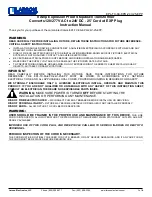
______________________________________________
HARRIS
888-9058-001
WARNING: Disconnect and lockout AC primary power prior to servicing
171
All wiring should be periodically checked for tight connections. This is most important
in the high-current circuits (cabinet AC feed, AC breaker to DC power supplies, power
supply to DC bus bars, DC bus to module connectors, etc.). Also check wires for lead
dress and abrasions. High-current wires may be physically jolted from their positions by
current surges at turn-on.
RF cables rarely give trouble, but should be checked for tight connection. Inspect for
signs of cables being pinched at sliding assemblies such as slave controllers.
7.7.4 Check MOV Boards
Periodically visually inspect all MOVs to ensure proper transient protection, especially
after thunderstorms. Replace if any damage is suspected.
7.7.5 Checking Multiple PA Cabinet Interlocks
Disconnect the thermal interlock switch and verify the correct PA cabinets do turn off.
If they do not turn off, check the jumper plug J15 is in the correct 1-2 position.
7.7.6 Cleaning
Use a vacuum cleaner as required to clean the cabinets. Be aware of static discharge
problems with the use of high velocity air in dry climates when cleaning any circuit board
with static sensitive components. A variety of static-safe vacuum equipment is
available at most computer supply dealers.
A soft natural bristled paint brush with metal binding and wood handle can be used to
dislodge dust with minimum static generation. Hold the metal binding and touch a
grounded surface to discharge any difference in potential before working on the board.
Do not use nylon brushes with plastic handles.
Printed circuit board edge connectors may be cleaned using a commercial cleaner such
as Cramolin or Stabilant 22A. Apply a small amount of the cleaner to the contacts, then
remove it with a clean, lint-free cloth. Do not use a pencil eraser to clean contacts, as
gold or silver contact plating will be removed. Also, many pencil erasers contain sulfur
which will cause oxidation. To clean motherboard sockets, wrap cloth around a small
plastic or metal card slightly thinner than the circuit boards. Apply a small amount of the
cleaner, and insert the cloth-covered card into the connector. Reposition the cloth to a dry
area to remove the cleaner.
Inspect the RF amplifier module fins for accumulated dirt that may have gone past the
air filters. Remove using a brush and vacuum. Do not spray any liquids that may seep
into the circuit board area. Outside panel surfaces may be cleaned with a damp cloth
using water or mild household cleaners.
















































